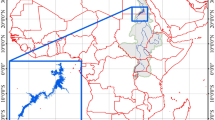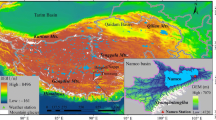Himalaya–Karakoram (H–K) region hosts large number of high altitude lakes but are poorly gauged by in-situ water level monitoring method due to tough terrain conditions and poor accessibility. After the campaigns of ICESat during 2003–2009, now it is possible to achieve lake levels at decimetre accuracy. Therefore, in present study, high altitude lake levels were observed using ICESat/GLAS altimetry in H–K between 2003 and 2009 to generate baseline information. The study reveals that out of 13 lakes, 10 lakes show increasing trend of water levels at different rate (mean rate 0.173 m/y) whereas three lakes unveiled decreasing trend (mean rate −0.056 m/y). Out of five freshwater lakes, four lakes show an increasing trend of their level (mean rate 0.084 m/y) whereas comparatively six salt lakes (out of seven salt lakes) exhibited ~3 times higher mean rate of lake level increase (0.233 m/y). These observed lake level rise can be attributed to the increased melt runoffs (i.e., seasonal snow and glacier melts) owing to the enhanced mean annual and seasonal air temperature during past decade in north-western (NW) Himalaya. Further, varied behaviours of lake level rises in inter- and intra-basins suggest that the local climatic fluctuations play prominent role along with regional and global climate in complex geographical system of NW Himalaya.




Similar content being viewed by others
References
Abdalati W, Zwally H J, Bindschadler R, Csatho B, Farrell S L, Fricker H A, Harding D, Kwok R, Lefsky M, Markus T, Marshak A, Neumann T, Palm S, Schutz B, Smith B, Spinhirne J and Webb C 2010 The ICESat-2 Laser Altimetry Mission; Proc. IEEE 98 735–751.
Archer D R and Fowler H J 2004 Spatial and temporal variations in precipitation in the Upper Indus Basin, global teleconnections and hydrological implications; Hydrol. Earth Syst. Sci. 8 47–61.
Babu Govindha Raj K 2010 Remote sensing based hazard assessment of glacial lakes: A case study in Zanskar basin, Jammu and Kashmir, India; Geomatics, Natural Hazards and Risk 1 339–347.
Berthier E, Arnaud Y, Kumar R, Ahmad S, Wagnon P and Chevallier P 2007 Remote sensing estimates of glacier mass balances in the Himachal Pradesh (Western Himalayas, India); Remote Sens. Environ. 108 327–338.
Bhambri R and Bolch T 2009 Glacier mapping: A review with special reference to the Indian Himalayas; Progr. Phys. Geogr. 33 672–704.
Bhambri R, Bolch T, Chaujar R K and Kulshreshtha S C 2011 Glacier changes in the Garhwal Himalayas, India 1968–2006 based on remote sensing; J. Glaciol. 57 543–556.
Bolch T, Kulkarni A, Kääb A, Huggel C, Paul F, Cogley G, Frey H, Kargel J, Fujita K, Scheel M, Stoffel M and Samjwal B 2012 The state and fate of Himalayan glaciers; Science 336 310–314.
Carroll M L, Townshend J R, DiMiceli C M, Noojipady P and Sohlberg R A 2009 A new global raster water mask at 250 m resolution; Int. J. Digital Earth 2 291–308.
Fowler H J and Archer D R 2006 Conflicting signals of climatic change in the Upper Indus Basin; J. Climate 19 4276–4293.
Fujita K and Nuimura T 2011 Spatially heterogeneous wastage of Himalayan glaciers; PNAS 108 14,011–14,014.
Fujita K, Suzuki R, Nuimura T and Sakai A 2008 Performance of ASTER and SRTM DEMs, and their potential for assessing glacial lakes in the Lunana region, Bhutan Himalaya; J. Glaciol. 54 220–228.
Fujita K, Sakai A, Nuimura T, Yamaguchi S and Sharma R 2009 Recent changes in Imja Glacial Lake and its damming moraine in the Nepal Himalaya revealed by in situ surveys and multi-temporal ASTER imagery; Environ. Res. Lett. 4 1–7.
Gardelle J, Arnaud Y and Berthier E 2011 Contrasted evolution of glacial lakes along the Hindu Kush Himalaya mountain range between 1990 and 2009; Global Planet. Change 75 47–55.
Gibson J J, Prowse T D and Peters D L 2006 Hydroclimatic controls on water balance and water level variability in Great Slave Lake; J. Hydrol. Process. 20 4155–4172.
Gujja B, Chatterjee A, Gautam P and Chandan P 2003 Wetlands and lakes at the top of the world; Mt. Res. Dev. 23 219–221.
Hall D K, Riggs G A, Salomonson V V, DiGirolamo N E and Bayr K J 2002 MODIS snow-cover products; Remote Sens. Environ. 83 181–194.
Hwang C, Kao Y C and Tangdamrongsub N 2011 A preliminary analysis of lake level and water storage changes over lakes Baikal and Balkhash from satellite altimetry and gravimetry; Terr. Atmos. Ocean Sci. 22 97–108.
Immerzeel W W, Van Beek L P H and Bierkens M F P 2010 Climate change will affect the Asian water towers; Science 328 1382–1385.
IPCC 2007 Climate Change 2007: Synthesis Reported Core Writing Team (eds) Pachauri R K and Reisinger A (Geneva: IPCC).
Kääb A, Berthier E, Nuth C, Gardelle J and Arnaud Y 2012 Contrasting patterns of early twenty-first-century glacier mass change in the Himalayas; Nature 488 495–498.
Komori J 2008 Recent expansions of glacial lakes in the Bhutan Himalayas; Quat. Int. 184 177–186.
Kulkarni A V 1996 Moraine-dammed glacial lake studies using remote sensing technique; Him. Geol. 17 161–164.
Kwok R, Zwally H J and Yi D 2004 ICESat observations of Arctic sea ice: A first look; Geophys. Res. Lett. L16401 31 1–5.
Lesher S R 2011 Climate change impacts to a high altitude lake in the Indian Himalaya; Disseration Thesis, San Diego State University.
Li X Y, Xu H Y, Sun Y L, Zhang D S and Yang Z P 2007 Lake-level change and water balance analysis at Lake Qinghai, west China during recent decades; Water Resourc. Manag. 21 1505–1516.
Liu J, Wang S, Yu S, Yang D and Zhang L 2009 Climate warming and growth of high elevation inland lakes on the Tibetan Plateau; Global Planet. Change 67 209–217.
Mason I M, Guzkowska M A J, Rapley C G and Street-Perrot F A 1994 The response of lake levels and areas to climatic change; Clim. Change 27 161–197.
Mason I M, Harris A R, Birkett C M, Cudlip W and Rapley C E 1991 Remote sensing of lakes for the proxy monitoring of climatic change; Proc. 16th Ann. Conf. Remote Sensing Society, pp. 314–324.
Medina C, Gomez E J, Alonso J J and Villares P 2008 Water level fluctuations derived from ENVISAT Radar Altimeter (RA-2) and in-situ measurements in a subtropical water body: Lake Izabal (Guatemala); Remote Sens. Environ. 112 3604–3617.
Mercier F, Cazenave A and Maheu C 2002 Interannual lake level fluctuations (1993–1999) in Africa from Topex/Poseidon: Connections with ocean–atmosphere interactions over the Indian Ocean; Global Planet. Change 32 141–163.
Nuth C and Kääb A 2011 Co-registration and bias corrections of satellite elevation data sets for quantifying glacier thickness change; The Cryosphere 5 271–290.
Panigrahy S, Patel J G, Singh T S and Murthy T V R 2011 National Wetland Inventory and Assessment: High Altitude Himalayan Lakes; SAC/ESPA/NWIA/IN/03/2010, pp. 1–20.
Phan V H, Lindenbergh R and Menenti M 2012 ICESat derived elevation changes of Tibetan lakes between 2003 and 2009; Int. J. Appl. Earth Observ. Geoinf. 17 12–22.
Philip G and Mazari R K 2000 Shrinking lake basins in the proximity of the Indus Suture Zone of northwestern Himalaya: A case study of Tso Kar and Startsapuk Tso, using IRS-1C data; Int. J. Remote Sens. 21 2973–2984.
Ramanathan V and Feng Y 2009 Air pollution, greenhouse gases and climate change: Global and regional perspectives; Atmos. Environ. 43 37–50.
Ramanathan V, Ramana M V, Roberts G, Kim D, Corrigan C, Chung C and Winker D 2007 Warming trends in Asia amplified by brown clouds solar absorption; Nature 448 575–578.
Schutz B E, Zwally H J, Shuman C A, Hancock D and DiMarzio J P 2005 Overview of the ICESat mission; Geophys. Res. Lett. L21S01 32 1–5.
Shekhar M, Chand H, Kumar S, Srinivasan K and Ganju A 2010 Climate-change studies in the Western Himalaya; Ann. Glaciol. 51 105–112.
Singh S P, Bassignana-Khadka I, Karky B S and Sharma E 2011 Climate change in the Hindu Kush-Himalayas: The state of current knowledge; Kathmandu: ICIMOD.
UNEP 2009 Recent Trends in Melting Glaciers, Tropospheric Temperatures over the Himalayas and Summer Monsoon Rainfall over India (Nairobi: United Nations Environment Programme).
Urban T J, Schutz B E and Neuenschwander A L 2008 A survey of ICESat coastal altimetry applications: Continental coast, open ocean island, and inland river; Terr. Atmos. Oceanic Sci. 19 1–19.
Wang X, Gong P, Zhao Y, Xu Y, Cheng X, Niu Z, Luo Z, Huang H, Sun F and Li X 2013 Water-level changes in China’s large lakes determined from ICESat/GLAS data; Remote Sens. Environ. 132 131–144.
Xu J, Grumbine E, Shrestha A, Eriksson M, Yang X, Wang Y and Wilkes A 2009 The melting Himalayas: Cascading effects of climate change on water, biodiversity, and livelihoods; Conserv. Biol. 235 20–30.
Zhang G, Xie H, Kang S, Yi D and Ackley S F 2011 Monitoring lake level changes on the Tibetan Plateau using ICESat altimetry data (2003–2009); Remote Sens. Environ. 115 1733–1742.
Zwally H J, Schutz B, Abdalati W, Abshire J, Bentley C, Brenner A, Bufton J, Dezio J, Hancock D, Harding D, Herring T, Minster B, Quinn K, Palm S, Spinhirne J and Thomas R 2002 ICESat’s laser measurements of polar ice, atmosphere, ocean, and land; J. Geodyn. 34 405–445.
Acknowledgements
The authors thank the Director, Wadia Institute of Himalayan Geology, Dehradun and Director General, Chhattisgarh Council of Science and Technology, Raipur for their support for this work. Priyeshu Srivastava thanks Prof. Sridhar Anandakrishnan of Penn State University, USA for his insightful comments and suggestion on earlier version of manuscript. Rakesh Bhambri thanks Eero Rinne of School of Geosciences, University of Edinburgh, UK for extracting ICESat tracks in shape files. They also thank U.S. National Snow and Ice Data Centre (NSIDC) for providing GLAS/ICESat altimetry data at no cost.
Author information
Authors and Affiliations
Corresponding author
Rights and permissions
About this article
Cite this article
SRIVASTAVA, P., BHAMBRI, R., KAWISHWAR, P. et al. Water level changes of high altitude lakes in Himalaya–Karakoram from ICESat altimetry. J Earth Syst Sci 122, 1533–1543 (2013). https://doi.org/10.1007/s12040-013-0364-1
Received:
Revised:
Accepted:
Published:
Issue Date:
DOI: https://doi.org/10.1007/s12040-013-0364-1




